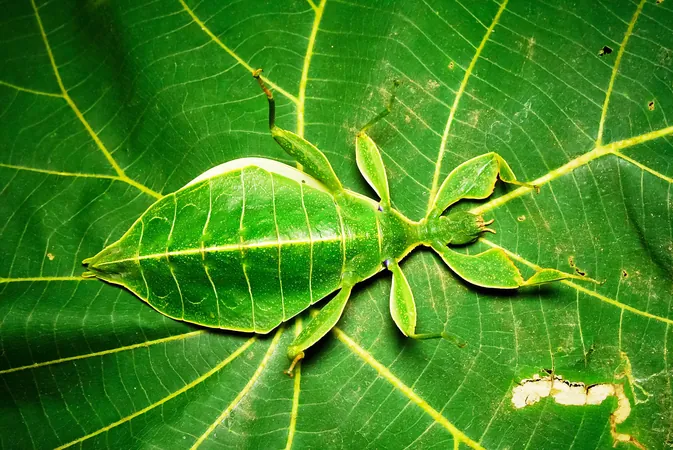
Nature's Master of Disguise: How Insects Fool Their Predators Using 3D Technology
2025-07-05
Author: Jia
The Art of Deception in the Insect World
In nature, looks can mean the difference between life and death. Many insects develop elaborate disguises to evade their predators. One of the most intriguing examples of this phenomenon is Batesian mimicry, where harmless species imitate the appearance of dangerous ones. The result? Predators learn to steer clear of insects that display warning colors and patterns, but some innocent bugs cleverly mimic these traits without any real threat.
Revolutionary Research Unveils New Insights
A groundbreaking study from the University of Nottingham has leveraged cutting-edge 3D printing technology to delve deeper into the world of insect mimicry. Researchers led by Dr. Tom Reader and Dr. Christopher Taylor have created lifelike insect models to answer the burning question: Why do some mimics closely resemble their dangerous counterparts while others barely make the effort?
Crafting the Perfect Imitation
Utilizing sophisticated imaging and morphing software, the team fashioned high-precision, life-sized replicas of both wasps and hoverflies. This innovative approach allowed them to manipulate traits like shape, size, and coloration with incredible detail—an unprecedented move beyond earlier studies that relied solely on natural insects.
Mimicry Under the Microscope: The Aesthetics of Survival
The Nottingham scientists aimed to understand what makes an effective mimic. They prompted thought-provoking 'what-if' scenarios, exploring how variations in color might enhance mimicry effectiveness. This allowed an exploration of a broader spectrum of questions concerning the elements of successful disguise.
Birds vs. Invertebrates: A Tale of Two Predators
In their experiments, real predators, specifically wild birds like great tits, were introduced to the insect models. It quickly became apparent that birds reacted sharply to color and size variations, rapidly learning to avoid mimic models that closely resembled wasps, even when those models were still palatable. Interestingly, intermediate mimics that combined traits from both models offered no added protection.
The Surprising Flexibility of Sloppy Mimics
Contrastingly, invertebrate predators, such as spiders, showed a more lenient attitude towards exact mimicry. Models that didn’t closely resemble their dangerous counterparts were still targeted, indicating a unique evolutionary dynamic: while birds push for perfection in mimicry, invertebrates allow for a broader range of survival strategies.
Mapping the Evolutionary Landscape of Mimicry
One of the pivotal achievements of this research is the creation of an adaptive landscape for examining mimicry. By constructing a system that illustrated how slight changes in traits affected predator choices, researchers found that while birds demanded precise mimicry, imperfections could survive in ecosystems dominated by less discerning predators.
The Future of Evolutionary Studies
Today’s 3D modeling and visualization techniques are paving the way for future studies in evolutionary biology. By simulating various species of hoverflies and testing them against predators, researchers aim to unravel the historical influences that shaped insect appearances.
A Window into Nature's Endless Evolution
This groundbreaking research not only sheds light on the intricate pressures that shape insect disguises but also serves as a valuable tool for understanding evolution at large. By marrying technology with biology, the findings reveal the remarkable adaptability and creativity present in nature, offering answers to enduring puzzles about survival strategies. This study stands as a testament to the incredible tricks insects have developed to navigate their perilous environments.
Published in the prestigious journal Nature, this research enriches our understanding of one of evolution’s most fascinating spectacles—the art of mimicry.



 Brasil (PT)
Brasil (PT)
 Canada (EN)
Canada (EN)
 Chile (ES)
Chile (ES)
 Česko (CS)
Česko (CS)
 대한민국 (KO)
대한민국 (KO)
 España (ES)
España (ES)
 France (FR)
France (FR)
 Hong Kong (EN)
Hong Kong (EN)
 Italia (IT)
Italia (IT)
 日本 (JA)
日本 (JA)
 Magyarország (HU)
Magyarország (HU)
 Norge (NO)
Norge (NO)
 Polska (PL)
Polska (PL)
 Schweiz (DE)
Schweiz (DE)
 Singapore (EN)
Singapore (EN)
 Sverige (SV)
Sverige (SV)
 Suomi (FI)
Suomi (FI)
 Türkiye (TR)
Türkiye (TR)
 الإمارات العربية المتحدة (AR)
الإمارات العربية المتحدة (AR)